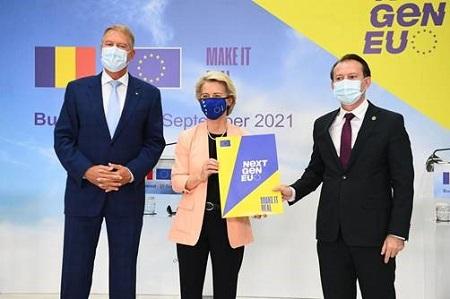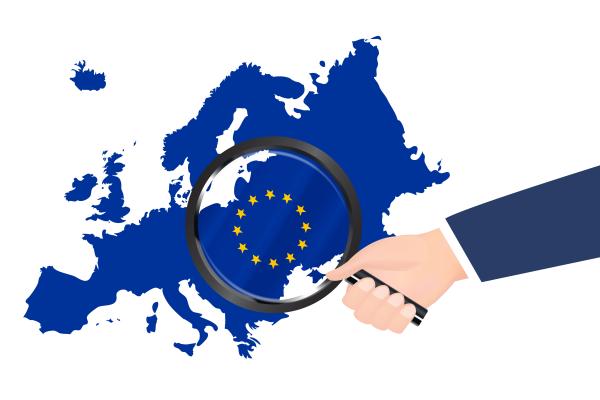Following the unprecedented crisis caused by the COVID-19 pandemic, Romania’s recovery and resilience plan has responded to the urgent need to foster a strong recovery, while making Romania’s economy and society more resilient and future ready. In response to the energy market disruption caused by Russia's invasion of Ukraine, the Commission launched the REPowerEU Plan. The Recovery and Resilience Facility is at the heart of its implementation and its funding. Under REPowerEU, EU countries have updated their recovery and resilience plans with new measures to save energy and diversify the EU’s energy supplies.

Green transition
Focusing on green technologies and capacities - sustainable mobility, energy efficiency and renewables, climate change adaptation; circular economy; and biodiversity.
Policies for the next generation
Improving access to and the quality of general, vocational, and higher education; focusing on digital education, early childhood education and care; supporting youth employment.
Smart, sustainable, inclusive growth
promoting entrepreneurship, competitiveness, industrialisation; improving the business environment; fostering research, development and innovation, supporting small- and medium-sized businesses.
Digital transformation
Promoting the roll-out of very high-capacity networks, the digitalisation of public services, government processes, and businesses, in particular SMEs; developing basic and advanced digital skills; supporting digital-related R&D and the deployment of advanced technologies.
Social and territorial cohesion
Improving social and territorial infrastructure and services, including social protection and welfare systems, the inclusion of disadvantaged groups; supporting employment and skills development; creating high-quality, stable jobs.
Health and economic, social and institutional resilience
Improving the resilience, accessibility and quality of health and long-term care, including measures to advance their digitalisation; increasing the effectiveness of public administration systems.
The map exclusively serves information purposes and is not an exhaustive database of projects supported by the Recovery and Resilience Facility. It does not reflect the distribution of the projects funded by the Recovery and Resilience Facility across the European Union, nor across different geographical areas or sectors within EU Member States. The RRF funding amounts shown for measures are based on the initial cost estimates included in the recovery and resilience plans.
Furthermore, the projects showcased are without prejudice to any future assessment by the Commission in the context of verifying the satisfactory fulfilment of milestones and targets under Regulation (EU) 2021/241 establishing the Recovery and Resilience Facility.
Country snapshot

The country snapshot illustrates some of the most iconic and impactful projects included in the Romanian Recovery and Resilience Plan that will bring positive change for EU citizens, businesses and the EU at large.
The reforms and investments in Romania’s plan are helping it to become more sustainable, resilient and better prepared for the challenges and opportunities of the green and digital transition. Following Council’s approval of Romania’s plan on 29 October 2021, Romania’s recovery and resilience plan was revised on 8 December 2023 also to introduce a REPowerEU chapter.
*The plan is entirely financed by RRF grants and loans and REPowerEU Grants.
**This value includes the transfer from the Brexit adjustment reserve requested by Romania and Romania’s REPowerEU grant.
- 111 investment streams and 66 reforms
- 44.1% of the plan will support climate objectives
- 21.8% of the plan will foster the digital transition
The transformative impact of Romania’s plan is the result of a strong combination of reforms and investments which address the country’s specific challenges. The reforms address bottlenecks to lasting and sustainable growth, while numerous investments are targeted towards the green transition, notably through sustainable transport, building renovation, biodiversity protection, industry decarbonisation and deployment of renewables. Romania’s plan also includes measures on digitalization of public administration and public services and improvement of healthcare and education sectors, in an approach that takes into account regional disparities. Important reforms and investments aim at improving the quality and sustainability of public finances and the pension system, the effectiveness of public administration, including state owned enterprises, public procurement, the judiciary and the fight against corruption, as well as support for the business environment and research & innovation.
All measures have to be implemented within a tight time frame, as the Regulation establishing the Recovery and Resilience Facility requires all milestones and targets within the national plans to be completed by August 2026.
REPowerEU measures in Romania’s plan
Romania's REPowerEU chapter consists of two new reforms and seven investments to deliver on the REPowerEU objectives to make Europe independent from Russian fossil fuels well before 2030. These measures focus on accelerating green energy production, promoting energy efficiency of buildings, and re- and up-skilling the workforce in the field of green energy production.
To finance the ambitious plan, Romania has requested to transfer its share of the Brexit Adjustment Reserve (BAR) to the plan, in line with the REPowerEU Regulation. These funds, added to Romania's RRF and REPowerEU grant allocation (amounting to €12.1 billion and €1.4 billion respectively), and to its RRF loans (€14.9 billion), result in an overall volume of €28.5 billion.
Key measures for the green transition
One reform introduces a legal framework for the use of non-productive or degraded state land for green energy production. Another reform sets up one-stop-shops to provide advisory services for energy efficiency renovations and energy production from renewable sources for households.
The seven investments in the REPowerEU chapter aim to accelerate the deployment of renewable energy sources, the pace of energy efficiency renovations and the requalification of the workforce towards green skills.
Green transition
In the area of climate and environmental policies, Romania’s challenges include the greenhouse-gas emissions that are set to increase and could jeopardise the achievement of 2030 and 2050 energy and climate targets. In addition, while Romania’s circular economy has potential, there is a particular need to improve infrastructure for water, waste, wastewater and air pollution management through additional investments.
Key measures for the green transition
- An investment tol support urban mobility through infrastructure for a green and safer urban transport.
- Reforms and investments amounting to €1.2 billion will support clean energy production by phasing-out of coal and lignite power production, deployment of renewables, and hydrogen.
- The plan includes an investment of €2.9 billion for energy-efficiency renovation and seismic consolidation of buildings.
The investment aims to increase the energy renovation rate of multi-family buildings and public buildings in Romania, one of the EU countries most exposed to seismic risk and therefore in need of energy renovation and seismic renovation.
- Project locations
- Romania
Digital transition
Digital challenges for Romania include connectivity especially in rural areas, lack of digital skills, below EU average digitalisation of schools, households, companies and public services. Existing capacities are not sufficient to ensure a high level of network security and adequate cyber risk management.
Key measures for the digital transition
Romania’s recovery and resilience plan supports the digital transition with investments and reforms for the digitalisation of public administration in key areas such as justice, employment and social protection, environment, civil service management and skills development, public procurement, cybersecurity, tax and customs, while building a secure government cloud infrastructure and supporting the e-Identity deployment.
- Public administration digitalisation investments amount to €1.4 billion.
- Investments for digitalisation of health (€442 million) support the development of an integrated e-Health system, connecting over 25,000 healthcare providers and developing telemedicine systems.
- Investments for digitalisation of education (€1.16 billion) aim at improving digital pedagogical skills, educational content and equipment and resources, including in universities.
The project aims to support the transition and adoption of the electronic identity card (e-ID card) for Romanian citizens.
- Project locations
- Romania
Economic and social resilience
Key challenges with an impact on Romania’s medium-term economic performance include growing fiscal and current account deficits stemming from a consumption-led growth model based on strong domestic demand, which was stimulated in recent years by expansionary fiscal policy. In addition, adverse demographic developments and shortages in the education system have led to labour and skill shortages and inequalities and regional disparities have been further accentuated by Covid-19 crisis. An unpredictable business environment is also a challenge of the Romanian economy.
Key measures in reinforcing economic and social resilience
The plan reinforces economic and social resilience by supporting the public administration with a large array of measures including improving the effectiveness of the judicial system, strengthening policy coordination and planning capacity of the government and improving human resources management in the civil service.
- Territorial and social cohesion will be fostered by development of road infrastructure and modernization of railways, as well as by reforming the Romanian social benefits system through the implementation of the minimum inclusion income reform and measures to improve the employment and social protection digital systems.
- Fiscal sustainability will be supported by reinforced budgetary framework, better expenditure control and review of taxation, and pension system reform.
The Romanian government approved in December 2022 the National Strategy on Long-Term Care and Active Ageing for 2023-2030.
- Project locations
- Romania
ANNUAL EVENTS
Annual events facilitate the exchange of views on the state of implementation of the Recovery and resilience plans, while ensuring close cooperation between all stakeholders and providing a platform to discuss interlinks between the Plans and other Union programmes.
More information on Annual events held in Romania can be found here
EUROPEAN SEMESTER
Romania’s plan is consistent with the challenges and priorities identified in the European Semester, the annual cycle of coordination and monitoring of each EU country’s economic policies. For a detailed explanation of the European Semester see the following link: The European Semester explained | European Commission (europa.eu)
National recovery and resilience website
Original Recovery and Resilience Plan (October 2021)
National recovery and resilience plan
Updated Recovery and Resilience Plan (December 2023)
Original Recovery and Resilience Plan (October 2021)
Documents
Commission Staff Working Document: Analysis of the recovery and resilience plan of Romania
Press Material
Press release: "European Commission endorses Romania's plan"
Factsheet: Romania’s recovery and resilience plan
Questions and answers: European Commission endorses Romania's plan
Further Information
Presentation to the Council of Romania’s recovery and resilience plan
Summary of the assessment of the Romanian recovery and resilience plan
Updated Recovery and Resilience Plan (December 2023)
Documents
Press Material
Pre-financing
Press release: Commission disburses €1.8 billion in pre-financing to Romania
First Payment Request
Documents
Preliminary assessment of the first payment request of Romania
Commission implementing Decision on the authorisation of the first disbursement to Romania
Press Material
Questions and Answers on Romania’s disbursement request
Daily News: Commission disburses first payment to Romania
Second Payment Request
Documents
Preliminary assessment of the second payment request of Romania
Commission implementing Decision on the authorisation of the second disbursement to Romania
Preliminary assessment of milestone 133 of the second payment request of Romania
Press Material
Third Payment Request
Documents
Preliminary assessment of the third payment request of Romania
Press Material

